The 27th EuroSTAR Software Testing Conference took place 11-14 November in Prague. Each year a member of the testing community summarises each day in a blog to share with the Huddle Community. This year I was busy sharing sketchnotes of each of the talks I attended from Tuesday to Thursday of the EuroSTAR Conference. Below is my first Community report – enjoy!
Tuesday at #EuroSTARConf
For the last few months, I knew that I would attend EuroSTARConf 2019 as the Community Sketchnote reporter and I was very much looking forward to it. Attending a great conference with lots of amazing speakers with great talks, doing sketchnotes of the talks and then share them with the community – this is just awesome!
So Tuesday 12th November was the day, the day the conference part of EuroSTAR started in Prague (the tutorials are on Monday). The Prague congress center was huge and had lots of space for all attendees. The EuroSTAR Team at the registration desk were really nice and welcoming. I received my badge, a backpack with information and an official t-shirt. That is so nice!
The program committee started the actual conference with some remarks. The theme this year is: Working well – purpose, practices, people, challenges. A fitting motto, in my opinion.
Developing your BS detector: The hype and reality of AI
The first keynote was by Dr. Chris McKillop. “Developing your BS detector: The hype and reality of AI” was the title of the keynote. It was about the fact that there is still a lot of BS in the world of AI and she explained symptoms of it.
The 6 main symptoms are:
- Confusion
- Singularity fever
- Deception
- Failure
- Data obsession
- Empathy Dysfunction
Plus there is a bonus symptom: the Dunning Kruger Syndrome. The cure is: Knowledge plus ethics plus empathy.
Why is my regression pack full of junk tests? The Endowment Effect
The next talk on my agenda was by Andrew Brown about “Why is my regression pack full of junk tests? The Endowment Effect“. He explained that the Endowment Effect is about the willingness to accept being bigger than the willingness to pay. You would rather retain an object you own than acquire it. This is unconscious behavior and can’t be modified easily. In regression packs, we often tend to write more test cases than we can maintain, but we still add more tests. Think about what happens to them and if they can be abandoned. We are biased by things like the IKEA or the Status Quo Effect. We have to understand that problems often occur out of thought processes.
Unlearning to facilitate learning
Viktorija Manewska spoke about “Unlearning to facilitate learning“. The brain is like a full cup of tea, to learn something new you need to unlearn something else. An example would be riding a backward bike where if you turn right, you go left and vice versa. You have to unlearn how to ride a bike to be able to ride this new bike. Unlearning doesn‘t mean forget but getting rid of old models and habits. It‘s similar in software testing. A new colleague will click around like a real user and find bugs you haven‘t found because he isn‘t limited by the models you have and the habits you gained from your experience. Exploratory testing might help you. When you want to male a shift, you need to make it on 3 levels: individual, group and organizational.
Lightning Strikes
The last point on the agenda for the Tuesday was the Lightning Talks slot by the tutorial speakers: Rob Lambert, Gáspár Nagy, Kristoffer Nordström, Iris Pinkster-O‘Riordain and Mais Tawfik Ashkar. Each of them had a maximum 4 minutes to talk about a topic of their choice. Rob was talking about stake and outcomes vs. rank and perks, Gáspár about how to find smart solutions and make them available, Kristoffer about fun at work and how this can increase creativity and productivity, Iris about paying attention to unintentional human behavior and Mais about paying attention to what you are paying attention to.
After the talks, the Accenture Networking drinks started in the Expo area. While enjoying some drinks & snacks the attendees were able to mingle with each other and to talk to the exhibitors. The lucky ones that booked some of the night events were picked up by buses to go to either the Testers‘ Party at the Municipal House or the Community Dinner on a Vltava River Cruise. I took part in the Community Dinner. It took place on a boat riding along all the sights of Prague. You could enjoy the view, enjoy some nice food and drinks, listen to live music and talk to the other attendees. A great ending to a great day.
Wednesday at #EuroSTARConf
Technology’s Feet on Society’s Ground
The second day at the EuroSTAR Conference 2019 in Prague started at 09:00 with a keynote from Fiona Charles. She spoke about “Technology’s Feet on Society’s Ground“ and showed the audience lots of examples of why we can’t always or shouldn’t trust AI totally. Algorithms still make mistakes and gather data, we don’t even know they are gathering. This leads to privacy violations and that more data is being collected than a person would like to be shared. Because we people are addicted to convenience, we tend to make choices that suit us well but which might be bad for the environment.
Fiona’s tips to fight this are:
- look for possible biases
- acknowledge technology’s limitations
- embrace human-centered computing
- build security in
- ground tech firmly in human society
- remember the small things that make up the fabric of society
Rediscover Exploratory Testing
Following Fiona’s keynote, I attended an amazing talk by Ingo Philipp with the title “Rediscover Exploratory Testing“. Ingo started by comparing exploratory testing with deodorant – the people who need it most don’t use it. He reminded us that tools do not test, but help us to test and that we shouldn’t automate chaos. He then compared software development to wrestling in the mud like a pig. The pig being the software and the mud being all the uncertainties around the IT. Software testing is then washing this dirty pig – there are no rules, no clear timelines and when you’re done, you can’t be sure it’s really clean. There is a knowledge gap between what we know and what we can know, and testing has the goal to close this gap. Something being tested means that it is being checked and explored. As exploration is central to testing, a human tester is needed. Some techniques are: session-based testing, requirements-based testing, tour-based testing, polychrome testing and scenario-based testing.
Expert Reviews and Usability Testing
After a 30-minute coffee break during which we attendees had time to stroll through the busy Expo area, eat a snack and drink a cup of coffee, there was another slot of talks. I went to the talk “Expert Reviews and Usability Testing” by Claudia Badell. Claudia told us about usability heuristics by Jakob Nielsen, especially visibility of system status, the match between system and real-world, user control and freedom and consistency and standards. Known examples help you find potential problems in your software. You can use heuristic analysis when you have a prototype or when you are testing a new feature. Keep in mind that some problems can only be found by users. Therefore, usability testing is very important as well. Usability testing can be either moderated or unmoderated. If you want to start with usability testing, you should plan what you want to learn from the test, define the tasks (in the tool, if unmoderated), conduct a pilot test, recruit participants and prepare the session.
During the lunch break once again we had the opportunity to explore the expo area and the other areas like the EuroSTAR Huddle, Test Clinic or the Test Lab. Of course, there was also some time for networking with other attendees.
Next Generation Keynotes
After lunch, there was a new style of session called “Next Generation Keynotes“. This was a slot dedicated to three possible future keynote speakers who are already accomplished speakers and were given the opportunity to give their first talk on the Keynote stage. They applied during the EuroSTAR Call for Speakers and were mentored/coached by Fiona Charles since the program launch in April so they would be well-prepared for their talk. Each talk was a max of 15 minutes.
The first speaker on stage was Adonis Celestine, with the talk “Why do lifts have Mirrors“. Customer experience is the x-factor behind successful companies. Just as mirrors in lifts keep people occupied, by adding some small tweaks to our software we can keep users occupied while, for example, waiting for a page to load. Traditionally testers mostly concentrate on the functionality of a product whereas customers think that customer experience is most important – so a shift in the mindset is needed. The experience can be at the level “appeal to me” (customer onboarding), “delight me” (customer retention) or “wow me” (customer loyalty). Adonis wanted us to keep in mind, that “wow” experiences often are personal and that customer experiences are made of moments, so we have to pay attention at all touchpoints.
The next speaker on stage was Shelley Lambert, talking about “The Art of Scaffolding“. Scaffolding means building a temporary structure that allows you to build the real thing. Along the way, you should always ask “did I help someone with that” to determine whether you are going in the right direction or not. You need to fail and to succeed together and to help your team members learn and grow as you go.
The last speaker on stage was Ryan Volker, with a talk titled “Hey Testers, Justify your Existence“. Ryan told us that there are dark and lonely times for testers in which they have to justify their existence and prove their value. He showed us that it’s important to be an advisor, not a salesperson and to keep in mind the following things:
- dialogue, not monologue
- listen, actively
- think about what you are really doing
- solution before process
- grow your comfort zone
Leadership: from Monolith to Pebbles
The next talk I was listening to was the one called “Leadership: from Monolith to Pebbles” by Adam Matlacz. Adam told us about his story from being the monolith who has the whole knowledge to building a shared understanding throughout his team. When given the chance to be the assistant test manager, he applied some copy-pasting onto the estimations for process duration, resource requirements, etc. from a previous test manager without thinking them through. As you might imagine this lead to crisis. To overcome the crisis and to not arrive at such a point again someday in the future, he learned, that there are three crucial parts to successful projects: the right culture, the right people and proper processes and structure.
Good intentions Fly out of the Window
After some time to get another coffee, I listened to Jantien van der Meer and her talk “Good intentions Fly out of the Window“. Jantien was working in a team where everything went quite well: they were pairing, had coding standards, did Three Amigos meetings and so on. But then they were given a deadline for a project and this changed their way of working and decreased the quality of the software. Upon investigation, Jantien discovered, that stress was the source of this bad way of working. The team members had fallen into their primal instincts to flee, freeze, fight or focus and started to feel really unhappy. In such situations, it is important to label/call your emotions by name. If you acknowledge your feelings, you can control them and steer yourself. If you stumble about such situations remember to ask for help, such reactions aren’t there by choice but because of primal instincts, so don’t blame the others and create awareness. For this, it is necessary to create a safe environment and to build trust and confidence.
Flying High – Test Automation in the Boeing 777
The time for the last keynote of the day has arrived: Alexandre Bauduin held a keynote about “Flying High – Test Automation in the Boeing 777“. Alex started by explaining some things about flight simulators and that they basically have to simulate everything so that everything feels real as if you are sitting in a real plane. With several million lines of code, 1-2 million parts and several kilometers of electric wires, it is quite complicated to test an airplane. With a new simulator from the XR line, it was possible to get new, Arduino-style hardware and a faster assembly. This led to the idea of automation. With strong version control, you can test on desktop. This makes distributed testing possible. The assembly (hardware) could be tested, artifacts need to be generated and it had to be fast. Automated checks would mean more time to test in the simulator and an automated setup can help the engineers. The test requirements are given by the authorities. Alex decided to use the framework FitNesse for automation. With the automation there were less subjective tests, the pilot know-how was part of the code and if the automation works, they could fly the plane. But keep in mind to challenge your automation and to challenge the established tests.
Although I attended a lot of talks and got a lot of input, the Wednesday of EuroSTAR 2019 was over very fast. I’m very much looking forward to the third day and hope to learn even more interesting things.
Thursday at #EuroSTARConf
Diversity Strikes
The third and final day of the 2019 EuroSTAR Conference started with something new: a Diversity Strikes session on the main stage. This was an opportunity for any conference attendee to speak about diversity and inclusion on the big stage in front of all delegates. All you had to do was complete a short proposal for your talk and submit it to the EuroSTAR Huddle team by Wednesday lunchtime. The Programme Committee then reviewed the many applications and selected 5 people to speak. Though it was hard to choose the 5 speakers, according to Programme Chair, Isabel Evans, I think the choice was spectacular.
The first one on stage was Dermot Canniffe who was talking about his invisible illness: hypersomnia. It leads to a cognition deficit, the urge of wanting to sleep during the day and temporary impairment of memory. Luckily he works in a team that uses BDD. This helps him a lot as he can rely on one single source of truth and find the way through the code base easier. This gives him confidence and by spreading the responsibility throughout the team, he gets included.
The next one to speak was Hanna Dernbrant. She told us about her experience as the only tester in a team. She first dealt with it by attending conferences and becoming part of the community. Then she decided to build an internal community at work of her own. Throughout the whole company, there were three testers who now meet on a monthly basis to share their knowledge. From being a minority they became experts in their field. Even though you are alone, you don’t have to be lonely.
The third diversity strikes speaker was Adam Sandman. He appealed to us to give second chances. To look beyond the obvious when you are hiring like different backgrounds or stories. Try to work with people who are new to your working field or who had to take a break from their professional life. We can all make a difference, so give people a chance to show that they can drive your company forward.
Number four on stage was Serena Tosoni. She is somebody who is very interested in diversity. She distinguishes between diversity with others, like gender, culture or background and diversity within ourselves, like you not being yourself at work in comparison to how you are at home. She reminded us that diversity is the art of thinking independently together and that as you are driven by your soul, you should be yourself.
And last but not least there was Veerle Verhagen who took part in a pub quiz where their questions about main characters and their sidekicks. The sidekick to Fox Mulder was Dana Scully – but Veerle wasn’t ok with that as Dana Scully is a main character on her own. When she confronted the quiz master he just responded “you look nice” and went away. Being unhappy about how this went, Veerle turned to the community through the EuroSTAR conference app. The people there were on her side and said that next time they will decide on the questions on their own and not let the quiz master provide the questions. Essentially, if you are unhappy with how something went, reach out to your community and social progress will happen.
Learning from Bugs
The next talk I attended was “Learning from Bugs” by Henrik Warne. He started to track interesting bugs. For him, interesting bugs are the ones of which he thinks “ah, didn’t think of that”. He notes them in a bugs.txt file so that he can review them later and learn from them. He has an entry template with things like date, symptom, cause, how the bug was found, what was the fix in where it has been fixed, what was the cause, how much time he spent to fix the bug and the lessons learned. If you want to start doing this as well, you need to write down the bugs as soon as possible, otherwise, you will forget important details. This kind of bug documentation is quite easy to do, helps you to reflect on bugs and you can learn from the lessons.
Ignite your Inner Innovator – Rebalancing for Testers
After a coffee break, during which the attendees had, once more, the chance to explore the Expo area and talk to fellow attendees, the next session slot started. I decided to listen to Chloe Burger talking about “Ignite your Inner Innovator – Rebalancing for Testers“. One day Chloe wasn’t able to breathe anymore – the stress was too high and the doctor told her to relax. So she started reading and running and doing other stuff the internet recommended on how to relax. This didn’t work that well. Instead, she concentrated on changing her system to self-heal. One important learning is to be aware of what you are doing. Breathing exercises can help you a lot to calm down. Another tip is to eat happiness – for being happy, people need serotonin. Serotonin is produced by tryptophan which the people have to obtain with food. If you want to beat your system, Chloe recommends asking why, discussing your feelings and finding your way from frustration to inspiration.
Be the Lord of Your OWN Rings: Build Your OWN Insider Testing Program
Now the time for the last keynote came. It was titled “Be the Lord of Your OWN Rings: Build Your OWN Insider Testing Program” and held by Dona Sarkar. Dona works at Microsoft and is part of the Windows Insider Program. Microsoft wanted to try a new process – not creating for the customers, but co-creating with them, because they thought that having a lot of users is a superpower. They learned that everyone has a problem, ideas for a solution and wants to be part of a community. So they have built the Windows Insider Program, a tribe with three rules:
- the mission to build the best Windows for everyone in the world
- Twitter being the place to communicate
- the CTA: install build, send feedback
Now they release test builds to the Insider, receive their feedback, build it in and close-the-loop and engage the community. They have built a culture of experiment and learn. The interesting part of all of this is to build and nurture the community. So Dona’s tips for that are:
- have clear WHY they should invest (benefits)
- co-create with them
- be their advocate and celebrate their wins
- share your stage
- have inside jokes and symbols
- meet regularly virtually or in-person
- be vulnerable and make it safe for them to be vulnerable
- keep learning together
- build for teamwork
- unlock creativity and embrace shenanigans
After the lunch break, there was the choice to either attend a workshop or attend the do-over sessions – the sessions that are most highly rated by the attendees. You can rate more than once but only your most recent rating is saved by the app. As I haven’t seen the two winners of the EuroSTAR Do-Over sessions yet, I decided to attend those.
Finding and Developing Software Testers – Lessons from a Testing Start-up
The first Do-Over winner was “Finding and Developing Software Testers – Lessons from a Testing Start-up” by Phil Royston. Phil is the opinion that testing is (still) done by people. Therefore, you need a people strategy. You need to forecast demand and supply, attract great people, educate and upskill and also retain them. Being a good software tester from the view of business is someone who does a job that fulfills the customer’s need or solves a problem. Colleagues say that a good software tester has to do the job effectively and efficiently. Software testing consists of technical work, people’s work and teamwork. One of the essential parts of being a great tester is having a growth mindset. Companies have to work with the motivation of their employees. These can be:
- psychological & safety: money, bonuses, benefits, things
- equity: fairness
- autonomy & self-will: the urge to direct one owns life
- relationships
- mastery: getting better (at things that matter)
- recognition & appreciation
- purpose
If you want to be a good leader, you need to give recognition, don’t talk, but listen, build trust and relationships, give feedback (well) and delegate and elevate.
DevOps: Test Alone
The second Do-Over Winner was “DevOps: Test Alone“, held by Bjorn Boisschot. In the last few years, according to Bjorn, there haven’t been lots of changes in the way we test things. A tester from the ’70s might actually be a tester nowadays. To survive we need to adapt our testing efforts from being reactive to being pro-active. We need to focus on delivering value to everyone being a part of the software cycle. Testing should be adopted as a strategy, not a task. Soft skills play a very important role in that. Also, DevOps practices like containerization or code quality have to be embraced. Production needs to be leveraged and experimentation should play a role.
That was actually it – the EuroSTAR Conference 2019 was over way too fast!!
I really enjoyed being there. The location, Prague Congress Center, was lovely, the speakers were amazing and the talks had great quality. I’m very much looking forward to next year’s edition in Antwerp. And who knows: Maybe I will be there as a sketchnoter once again.

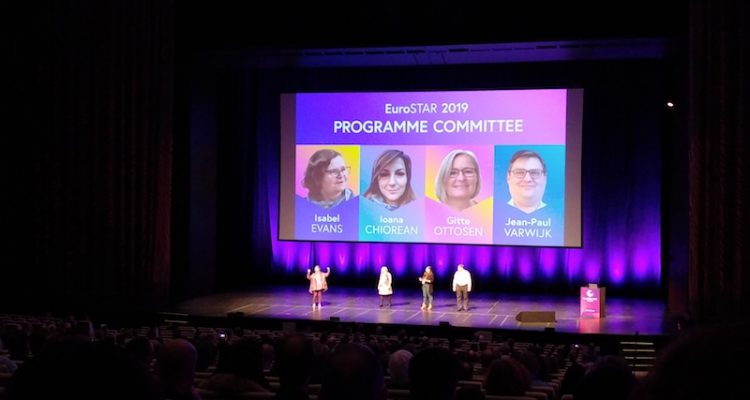
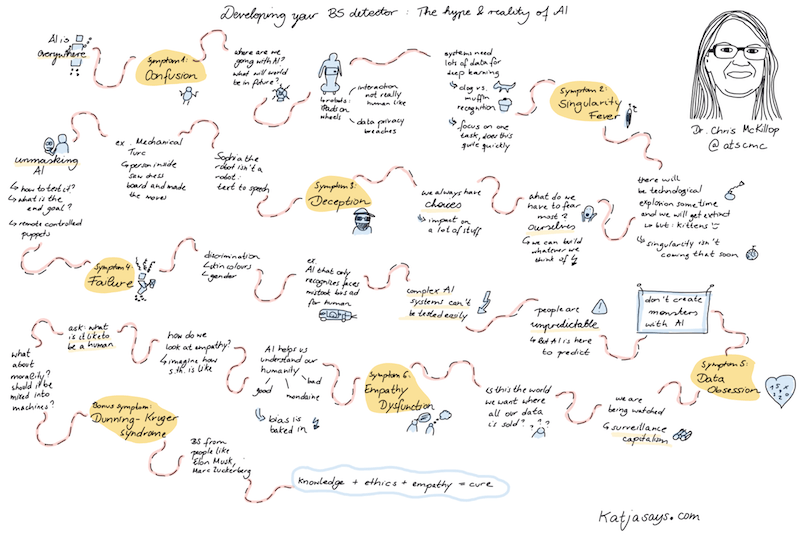
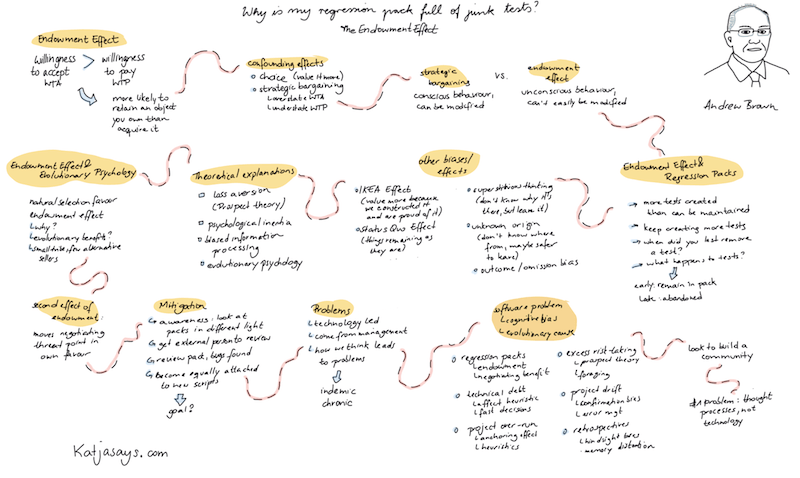
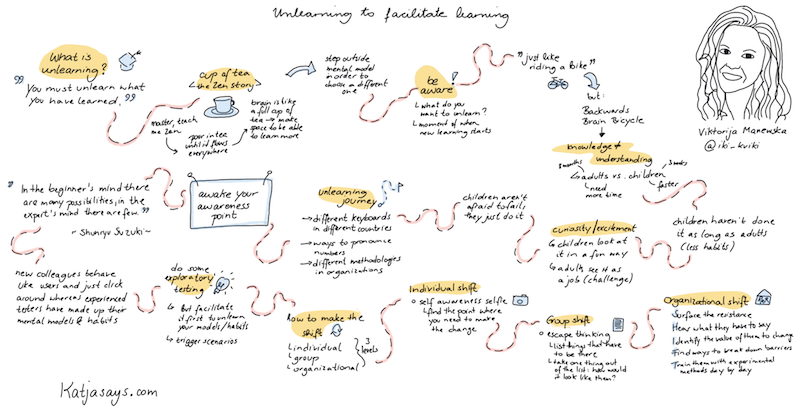
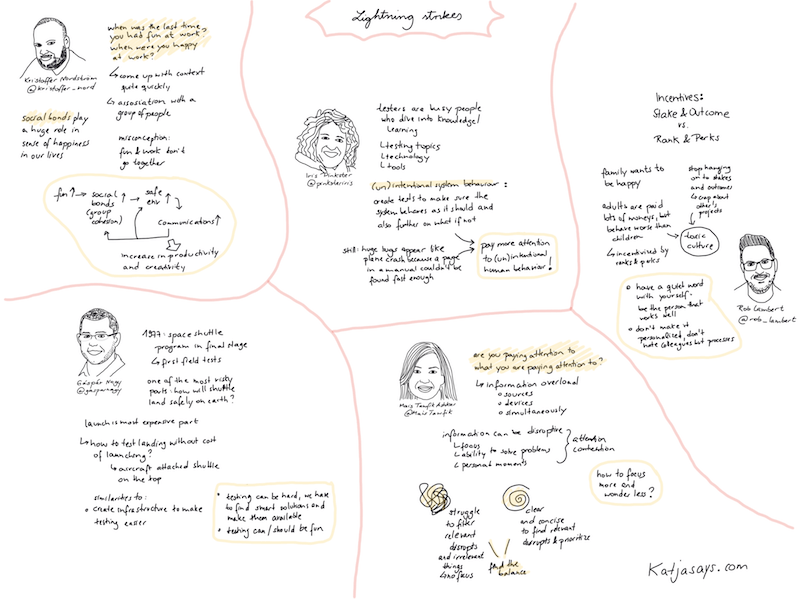
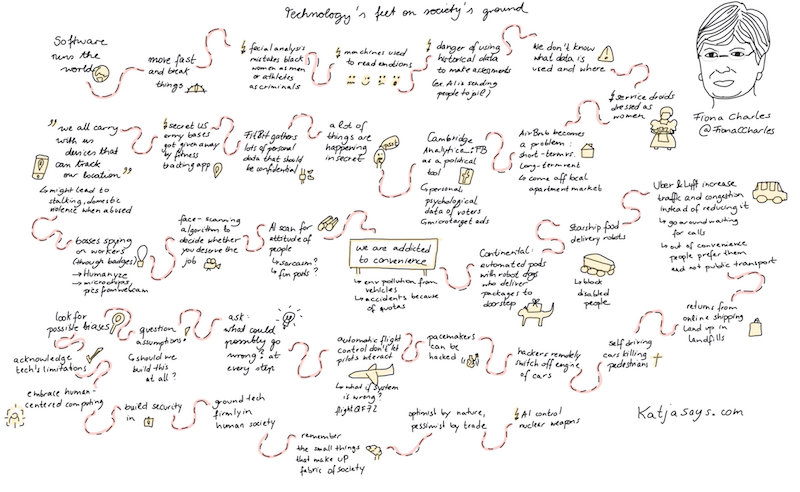
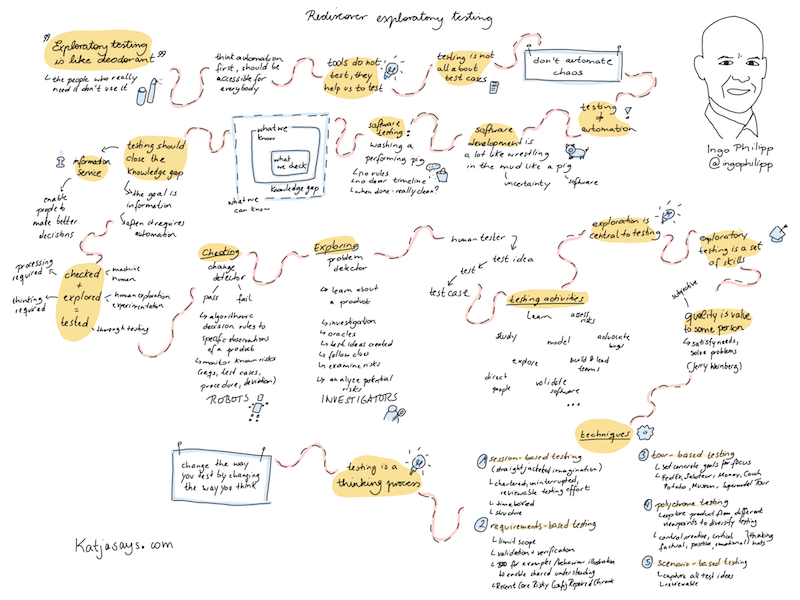
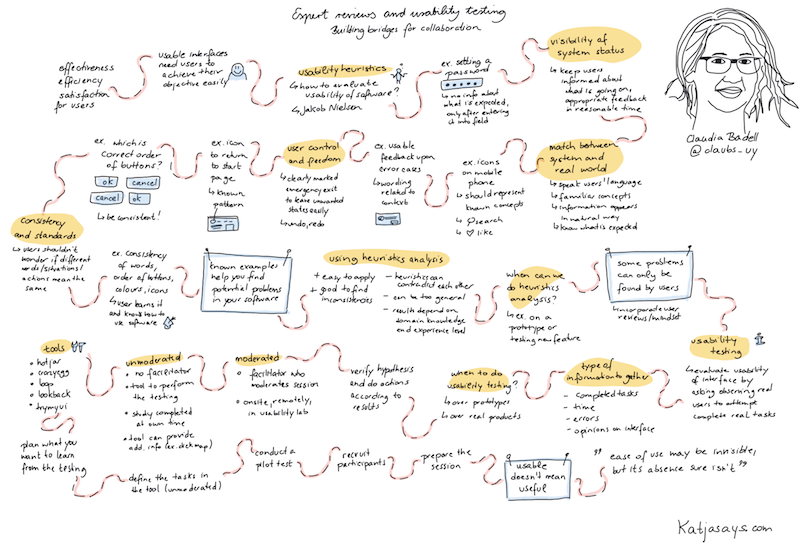
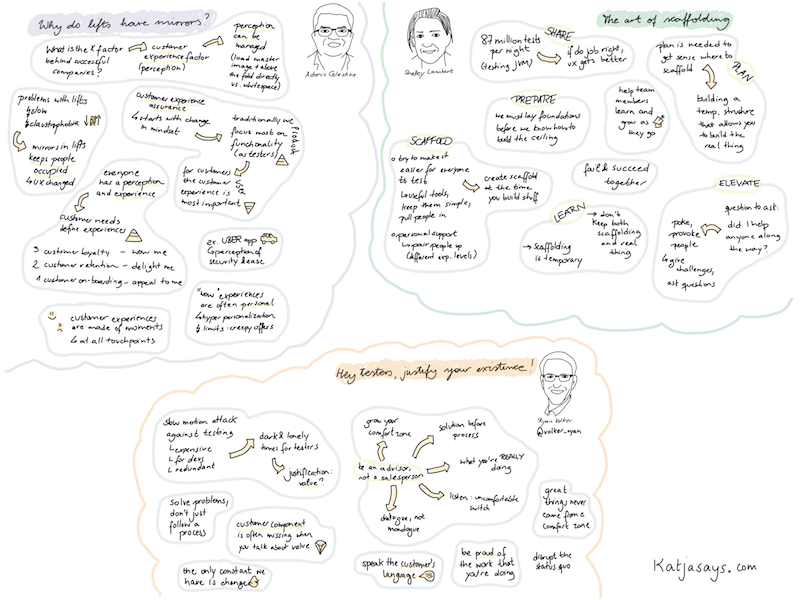
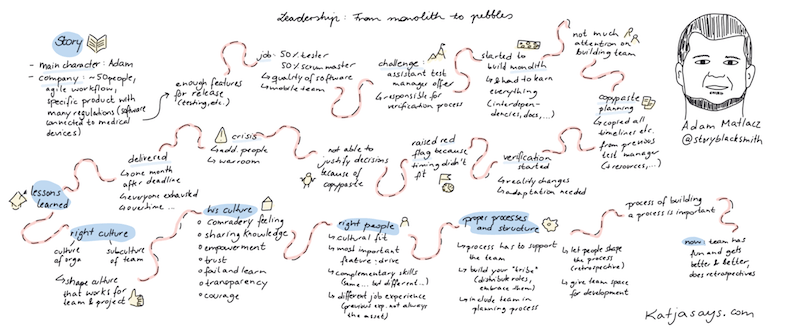
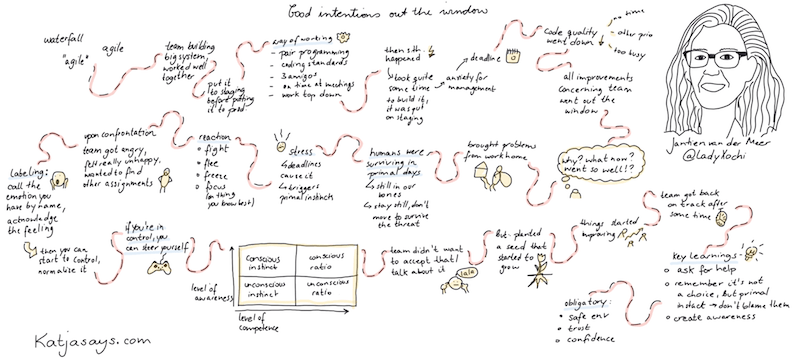
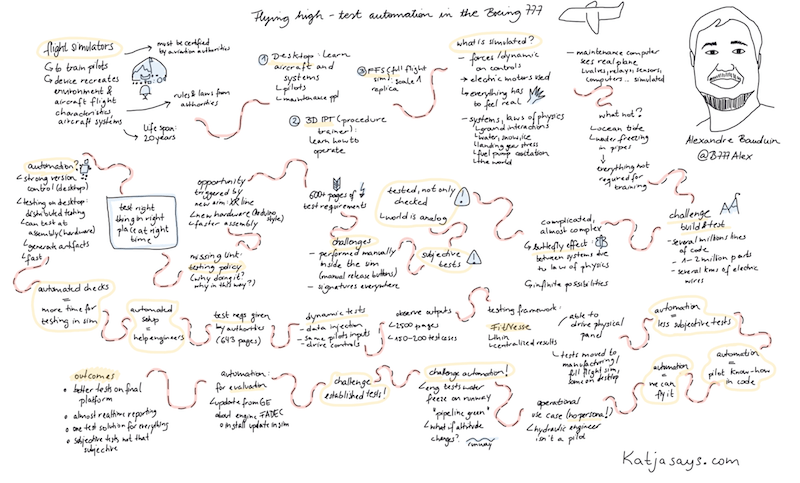

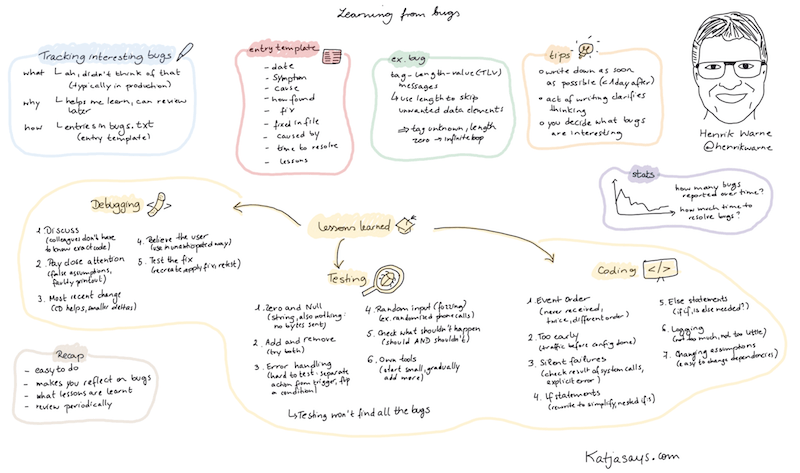
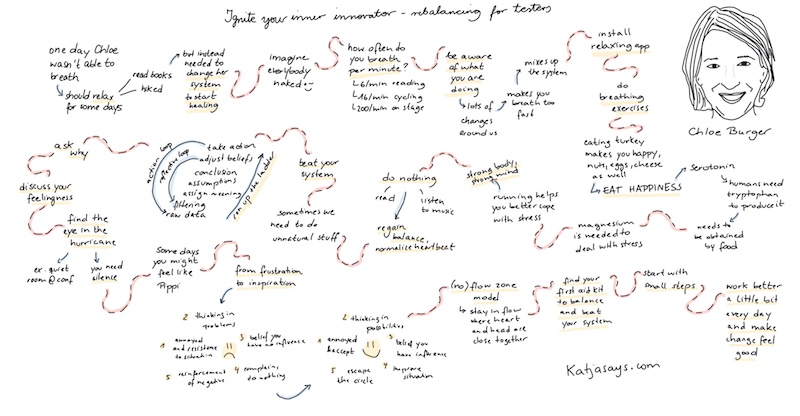
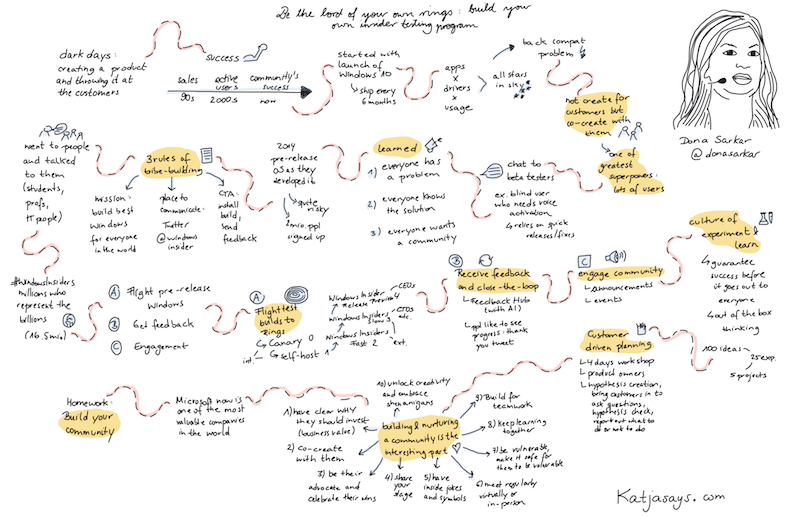
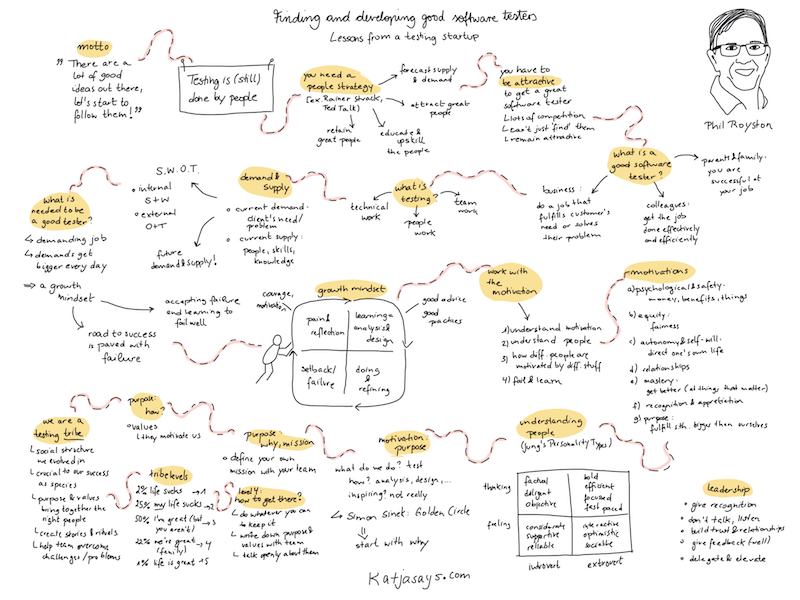
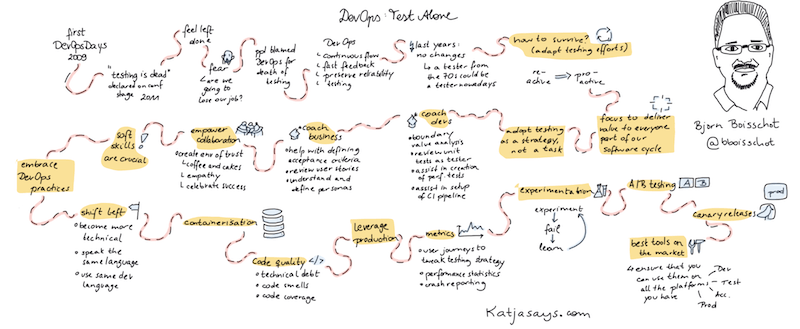
[…] EuroSTAR Conference 2019 Sketchnotes and Recap – Ekaterina Budnikov – https://www.katjasays.com/eurostar-2019-sketchnotes-and-recap/ […]